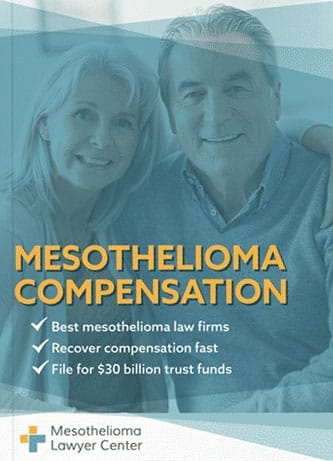Textile mill workers faced high risks of asbestos exposure on the job. Textile mills contained asbestos in machinery and often made textiles embedded with asbestos. Former textile workers are now at greater risk of developing mesothelioma, and many have filed lawsuits to seek damages.
If you suffer from mesothelioma, asbestosis, or asbestos-related cancer, you may be eligible for a large amount of compensation. Currently, there is over $30 billion in asbestos trust funds set up for those who have been diagnosed with an asbestos-related illness. Fill out our form to get a free Financial Compensation Packet. You’ll learn about the experienced mesothelioma lawyers in your area, how to get paid in 90 days, how to file a claim for the asbestos trust funds, and more.


FREE Financial Compensation Packet
- Info on law firms that will recover your HIGHEST COMPENSATION
- Learn how to get paid in 90 days
- File for your share of $30 billion in trust funds
Did Textile Mills Use Asbestos?
Like most industrial workplaces, textile mills have used asbestos in machinery, equipment, and building materials for decades. Many textile mills also used asbestos to manufacture products. Asbestos textiles were made for a variety of industries.
Textile mills today no longer use asbestos in equipment or processes. Most of the risk of asbestos exposure was in the past. However, current textile factory workers could still be exposed to asbestos through older materials.
What Do Textile Workers Do?
Textile workers generally work in the manufacturing mill, making textiles using raw materials, wool, cotton, and polyester.
Textile workers have a variety of different job functions, which may include:
- Setting up, operating, maintaining, and running textile machines
- Repairing machinery
- Bleaching and dyeing textiles and operating bleaching equipment
- Testing and inspecting materials
- Supervising and managing production lines
- General maintenance and cleanup
According to the U.S. Bureau of Labor Statistics (BLS), textile mill workers usually work in three different areas of the textile industry: apparel manufacturing, textile production mills, or textile mills.
How Were Textile Workers Exposed to Asbestos?
Throughout the 1940s until the late 1970s, many products produced in textile mills were made with asbestos and asbestos-containing materials (ACMs). Additionally, textile mills used asbestos in equipment and machinery used to make products.
This placed textile workers at a heightened risk of inhaling and ingesting asbestos, leading to the threat of developing toxic illnesses such as malignant mesothelioma, asbestosis, and asbestos-related lung cancer.
Workers with the highest risks of exposure handled asbestos to make asbestos textiles. Handling raw asbestos causes fibers to be released into the air, where workers can inhale them. Other workers in the area were also at risk of exposure.
Even in mills that did not use raw asbestos fibers to make textiles, workers faced exposure from equipment. Asbestos parts often released fibers due to natural deterioration and friction and when workers made repairs or performed maintenance tasks.
Although today’s textile manufacturing centers do not use asbestos as much as they once did, the sheer amount of people who were once exposed to asbestos while working in textile mills is astounding.
Asbestos Products Used in the Textile Industry
The most obvious source of asbestos in textile mills that exposed workers was raw asbestos. This was used in mills that manufactured asbestos textiles. Some of the types of asbestos products workers made in textile mills include:
- Fire curtains
- Roofing felt
- Fireproof clothing
- Asbestos aprons
- Potholders and oven mitts
- Welding blankets
- Asbestos rope
Many other products in textile mills contained asbestos, including those that made asbestos products and those that did not:
- Insulation
- Pipe lagging
- Boilers and furnaces
- Gaskets
- Valves
- Machinery brakes and other friction parts
The Risk of Asbestos Illnesses in Textile Workers
Scientific studies have been carried out on textile workers and asbestos, confirming that these workers are at a heightened risk of developing asbestos diseases.
- A study published by the U.S. National Institutes of Health (NIH) studied people who worked in four textile plants in North Carolina and chrysotile asbestos from January 1950 until December 1973. Of the 5,770 workers included in the study, 277 people died from some form of lung cancer, including pleural mesothelioma, a disease directly linked to asbestos exposure. Those who developed asbestos illnesses were exposed more significantly to asbestos than others.
- Another study was a follow-up of a previous study that found an increased risk for both pleural and peritoneal mesothelioma in textile workers. Not many studies have investigated the connection between textile work and peritoneal mesothelioma, a rarer, abdominal form of mesothelioma. This study found that the risk of developing persisted, even years after workers were no longer exposed to asbestos.
A study published in 2018 followed cases of mesothelioma diagnosed in women and men from 1993 to 2012. The researchers found that many of the women with mesothelioma worked in chemical and plastic factories. ut, the highest rates of mesothelioma among women in the study were among those who worked in textile factories.
Manufacturers That Supplied Asbestos to Textile Mills
In the past, manufacturers supplied asbestos-containing products to textile mills. If a textile worker develops an asbestos illness, the manufacturers that supplied the products could be liable for damages.
The most notable manufacturers include:
- Du Pont De Nemours and Company, Inc.
- Southern Textile Corp.
- Raymark Industries
- Johns Manville
- Southern Asbestos Company
- Regal Textile
- H.K. Porter Co.
- Coats & Clark Thread Company
What to Do if You Worked in a Textile Mill
Past textile workers are at an increased risk for asbestos illnesses. f this includes you, talk to your doctor about your risk for mesothelioma and other illnesses. An early diagnosis gives you more treatment options and a better outcome.
The next step is to contact a mesothelioma lawyer to determine your options for seeking compensation. You could be eligible to file a lawsuit against asbestos suppliers or to file a claim with an asbestos trust fund. Your lawyer can review your work history and find all possible avenues for recovering damages.
Additional Resources and Assistance for Textile Workers
Don’t forget to fill out our form for our free Financial Compensation Packet, filled with information on the experienced asbestos and mesothelioma attorneys in your area. You may be entitled to damages for pain, suffering, medical expenses, lost wages, and more. For additional assistance, contact us at 800-793-4540.

Paul Danziger
Reviewer and EditorPaul Danziger grew up in Houston, Texas and earned a law degree from Northwestern University School of Law in Chicago. For over 25 years years he has focused on representing mesothelioma cancer victims and others hurt by asbestos exposure. Paul and his law firm have represented thousands of people diagnosed with mesothelioma, asbestosis, and lung cancer, recovering significant compensation for injured clients. Every client is extremely important to Paul and he will take every call from clients who want to speak with him. Paul and his law firm handle mesothelioma cases throughout the United States.
References
- Loomis, D., Dement, J.M, Wolf, S.H., and Richardson, D.B. (2009, March 11). Lung Cancer Mortality and Fibre Exposures Among North Carolina Asbestos Textile Workers. Occup. Environ. Med. 66(8), 535-42.
Retrieved from: http://www.ncbi.nlm.nih.gov/pubmed/19282317 - Pira, E., Romano, C., Violante, F.S., Farioli, A., Spatari, G., La Vecchia, C., and Boffetta, P. (2016, September). Updated Mortality Study of a Cohord tof Asbestos Textile Workers. Cancer Med. 5(9), 2623-28.
Retrieved from: https://www.ncbi.nlm.nih.gov/pmc/articles/PMC5055168/ - Marinaccio A., Corfiati M., Binazzi A., Di Marzio D., Scarselli A., Ferrante P., Bonafede M., Verardo M., Mirabelli D., Gennaro V., Mensi C., Schallemberg G., Mazzoleni G., Merler E., Girardi P., Negro C., D’Agostin F., Romanelli A., Chellini E., Silvestri S., Pascucci C., Calisti R., Stracci F., Romeo E., Ascoli V., Trafficante L., Carrozza F., Angelillo I.F., Cavone D., Cauzillo G., Tallarigo F., Tumino R., Melis M., and Iavicoli S. (2018, April). The Epidemiology of Malignant Mesothelioma in Women: Gender Differences and Modalities of Asbestos Exposure. Occup. Environ. Med. 75(4), 254-62.
Retrieved from: https://www.ncbi.nlm.nih.gov/pmc/articles/PMC5878657/
